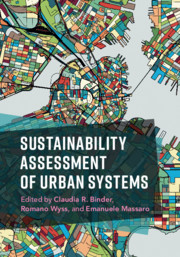Book contents
- Sustainability Assessment of Urban Systems
- Sustainability Assessment of Urban Systems
- Copyright page
- Contents
- Preface
- Acknowledgments
- Contributors
- General Introduction
- Part I Theoretical Background
- Part II Integrative Approaches for Sustainability Assessment
- Part III Perspectives on Urban Sustainability
- 10 Conceptualizing Urban Systems for Sustainability Assessment: Four Powerful Metaphors
- 11 Sustainability Issues in Urban Systems from a Metabolic Perspective
- 12 Urban-Industrial Supply Systems
- 13 Indicators for Assessing the Sustainability of Cities
- 14 Ontology-Based Integration of Urban Sustainability Indicators
- Part IV Focal Points of Urban Sustainability
- Index
- References
10 - Conceptualizing Urban Systems for Sustainability Assessment: Four Powerful Metaphors
from Part III - Perspectives on Urban Sustainability
Published online by Cambridge University Press: 27 March 2020
- Sustainability Assessment of Urban Systems
- Sustainability Assessment of Urban Systems
- Copyright page
- Contents
- Preface
- Acknowledgments
- Contributors
- General Introduction
- Part I Theoretical Background
- Part II Integrative Approaches for Sustainability Assessment
- Part III Perspectives on Urban Sustainability
- 10 Conceptualizing Urban Systems for Sustainability Assessment: Four Powerful Metaphors
- 11 Sustainability Issues in Urban Systems from a Metabolic Perspective
- 12 Urban-Industrial Supply Systems
- 13 Indicators for Assessing the Sustainability of Cities
- 14 Ontology-Based Integration of Urban Sustainability Indicators
- Part IV Focal Points of Urban Sustainability
- Index
- References
Summary
The conceptualisation of urban systems is a crucial step in their assessment. It not only involves identifying the constituent parts of an urban system, but also directly influences the definition of appropriate measurement tools, evaluation criteria, and stakeholders for the assessment. Choices related to conceptualisation therefore have strong normative implications. Hence, there is a need to develop ways to analyse and compare different approaches in terms of their relative emphases, strengths, and weaknesses. The purpose of this chapter is to respond to this need by developing analytical tools that build on four contrasting metaphors commonly used for describing cities. The set of four metaphors (machine, organism, network, and melting pot) used for this purpose were selected based their ability to capture different existing scientific perspectives on cities. Through elaborating the implications that each of the four metaphors carries for the different aspects of an urban system, our work produced two frameworks, one for analysing approaches to conceptualising urban systems in general, and another directed more specifically at analysing approaches to the assessment of urban systems. In addition to their analytical functions, these frameworks can also provide the language that enables communication between different scientific approaches to urban systems.
- Type
- Chapter
- Information
- Sustainability Assessment of Urban Systems , pp. 241 - 260Publisher: Cambridge University PressPrint publication year: 2020



